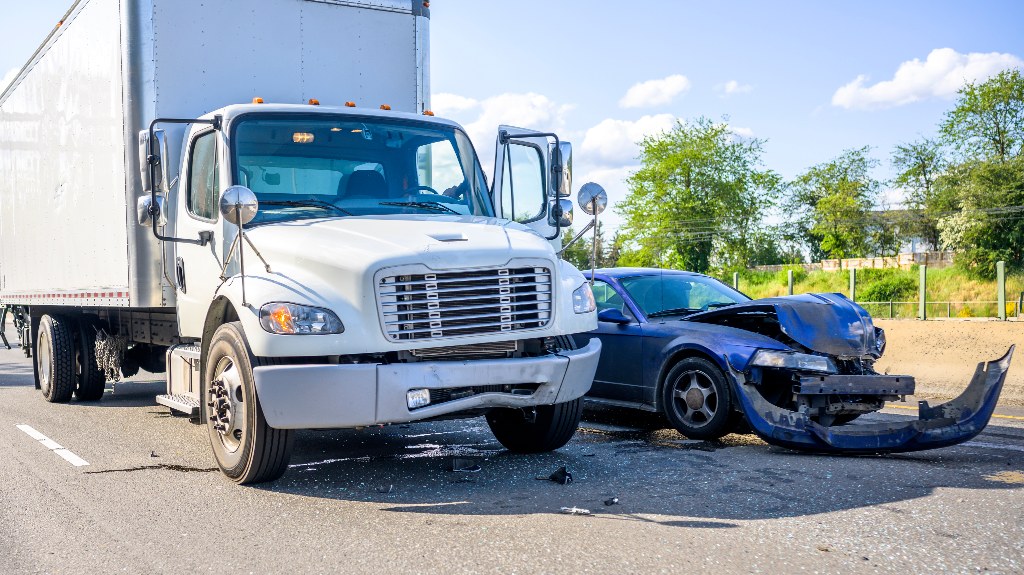Truck & Semi Accident Attorney Columbus OH
We have handled millions of dollars of commercial trucking accident claims over our combined 75 years of KLS experience. Unfortunately, these cases are some of the most complex, tragic, and bitterly fought court cases, in part because usually the damages truckers inflict on victims are death or a life time of horrible pain, suffering and disfigurement. The size and weight of semi trailers, logging trucks, and even smaller commercial delivery vehicles, make the accident significantly more dangerous for car and motorcycle drivers.

Case Studies (PDF files – open in new tab):
Representation Just as Excellent the Second Time Around
High Level of Professionalism is the Hallmark of Successful Litigation
Truck Crash Injury Claims:
- Semi truck tractor trailer injuries
- Big rig and dump truck crash injuries
- Delivery van accident injury claim
- Commercial Motor Carrier Safety Administration violations
- Drunk truck driver accident
- Wrongful death and catastrophic injuries
- Log book violations
- Untrained truck driver, unlicensed truck driver accidents
- Loose freight injuries
- Improper stop safety procedures
- Car accident injury claims
Truck Accidents Causing Catastrophic Injuries
Almost half of all spinal cord and brain injuries result from traffic accidents, and some of the most common types of truck accidents are likely to cause these injuries. These accidents most commonly include under ride/override accidents, rollover accidents, and jackknifing. These crashes often damage a victim’s head or upper back, resulting in the most severe spinal cord and brain injuries. Treating these injuries is expensive, often costing hundreds of thousands or even millions of dollars, and victims sometimes require lifelong care.
Safety When Driving
Tractor-trailers are 11 million strong on our U.S. Highways and log over 288 billion miles each year. Driving alongside these big rigs safely is something all motorists should know how to do.
Ohio 18-Wheeler Accident Attorneys Serving Clients Nationwide
When 18-wheelers cause collisions, the damages are often serious and deadly with the majority of these claims involving truck drivers smashing someone or something in the rear. Sleepiness and inattentiveness are two of the biggest reasons why wrecks happen.
What are the safety rules for truckers and their employers? Here are some important rules of the road that they must obey.
Truckers’ Safety Rules of the Road
CDL Driving Regulations
To drive professionally, commercial semi truck drivers must have a commercial driver’s license. This is called a “CDL.” To obtain a CDL, the U.S. Department of Transportation (DOT) requires a driver to pass a series of tests. The laws vary from state to state, but all must abide by federal DOT laws and regulations. The Federal Motor Carrier Administration has rules known as the Federal Motor Carrier Safety Regulations (FMCSRs). Below are many of the rules of the road that are important to know in trucking litigation. The rules include how much insurance the company must purchase and indicate no texting, for instance.
Furthermore, the regulations require that the drivers are proficient and be tested in a number of actions including:
- Maneuvering, parking, backing up, etc.
- Maintenance of engines, lights, tires, etc.
- Pre-trip inspection routine mastery
- Hazardous materials containment regulations and procedure
Also, a driver must pass a drug test and a physical exam.
Log Books Regulations
Semi truck drivers must keep a logbook and record as follows when they are on the roads:
- The number of hours they drive each day and the amount of time they rest. For instance, a driver can drive a maximum of 11 continuous hours and then must rest for 10 hours. Driving 60 hours or more in a seven-day period or 70 hours in an eight-day period is illegal. They must take off 34 consecutive hours after this in order to restart the countdown on a new 7 or 8 day driving period.
- The date they picked up their cargo “load”
- The weight of the truck rig before and after cargo is onboard
- The destination
- The time off, the time sleeping in the berth
- The date of delivery
- Total miles driven
- Signatures
- Which carrier they have
Finding Evidence of Regulation Violations
We must prove negligence or carelessness in a semi truck collision in order to win the case. Sometimes semi truck drivers knowingly, willfully, and recklessly violate the law. These flagrant violations can even be criminal. If we prove willfulness, recklessness, or criminality, sometimes we can obtain punitive damages in addition to actual damages. Actual damages include pain and suffering, lost income and wages, and medical bills, for instance.
It is our experience that when we represent the victim in a semi collision case, we must file suit against the driver and his or her employer very early on. Once we file a lawsuit, we then subpoena all the information noted above, and much more. We also gain access to the truck driver’s actual logbook. In it, we may find evidence of falsification or embellishment of entries.
We also take depositions (recorded statements with a court reporter) from the driver, his boss, and coworkers, among many others. This is all invaluable information to prosecuting the case.
In a semi truck collision, we always check to see:
- Whether the driver’s CDL license was active or suspended;
- Whether the driver has a criminal record;
- How many prior tickets the driver received;
- How many wrecks or incidents the driver was in;
- The driver’s financial background, including outstanding debts and judgments;
- The driver’s work history;
- The driver’s employment training and supervision;
- The driver’s use of drugs or medications;
- The driver’s ongoing training and work load;
- Whether the driver’s cargo load was over the legal limit;
- What the maintenance has been on the tractor and trailer;
- Whether the driver was driving over the allowed legal number of hours;
- Whether the driver strayed or departed from the intended route and destination
- Whether the driver was under the influence of narcotics or medication
- Whether the driver was drunk or high from alcohol or drugs
- Whether the driver was driving distracted such as using a cell phone, texting or eating
If you’re in a collision with a semi-trailer truck, make sure you:
- Call the police: Often a collision with a semi truck will block traffic or substantially reduce traffic flow. Additionally, you or your passengers may have injuries. A police report is a crucial piece of evidence. The police report will include:
- The semi truck driver’s contact and personal information (If he works for a trucking company, make sure you ask the police to get that contact information as well.);
- The name of his insurance company and that of his employer;
- A diagram of the collision scene;
- Witnesses’ names and contact information and statements;
- Photographs;
- Indicate who is at fault including speeds, distances, markings, and other important data;
- Weather conditions;
- Notations of any tickets the truck driver received
- Take Photographs: If at all possible, use your camera or cell phone to take photographs of the scene. Include photos of the truck and your car. Specifically photograph the point of impact. Look for and photograph skid marks as well. Try to photograph the truck driver and any witnesses. Look for damaged signs or other evidence of the collision. Take photos using a 360 degree approach.
- Take notes: If you don’t have a memo pad, write on any paper you can find. If not, type the information into your cell phone. Write down your observations at the scene. Be sure to note admissions the truck driver may make like, “I’m sorry,” or “I didn’t see you.” Also, do the same with witnesses who may have heard admissions the driver made. As soon as possible, transfer all your notations into a journal.
- Get contact information and statements from witnesses: Witnesses and their statements are critical to a case. The police may not have spoken with all of them. If they did, it’s unlikely the officers took down much of what they said. Obtain as much contact information as possible. Make sure you write down what they saw especially if they saw the trucker run a red light, fail to yield to you, etc.
- Look for surveillance cameras: Look for surveillance cameras at the scene. You can find them attached to businesses, schools, or city- or state-owned light poles that take photographs of intersections or railroad crossings. Try to convince the video owners to give you a copy. If not, your attorney can subpoena them once the lawsuit is filed.
- Return to the scene: The next day, if you’re well enough, return to the scene or get your lawyer to do so urgently. If you can’t, have a friend or family member help. You want to measure skid marks and photograph any signs or other solid objects that someone may have moved since the wreck. Talk to nearby neighbors or vendors to see what others may have heard or seen or done.


